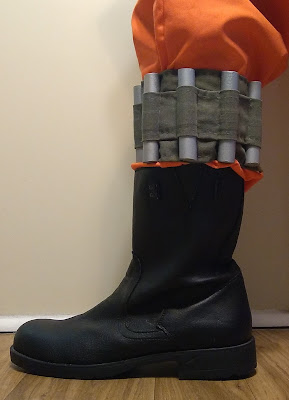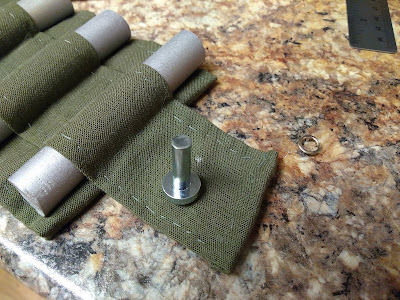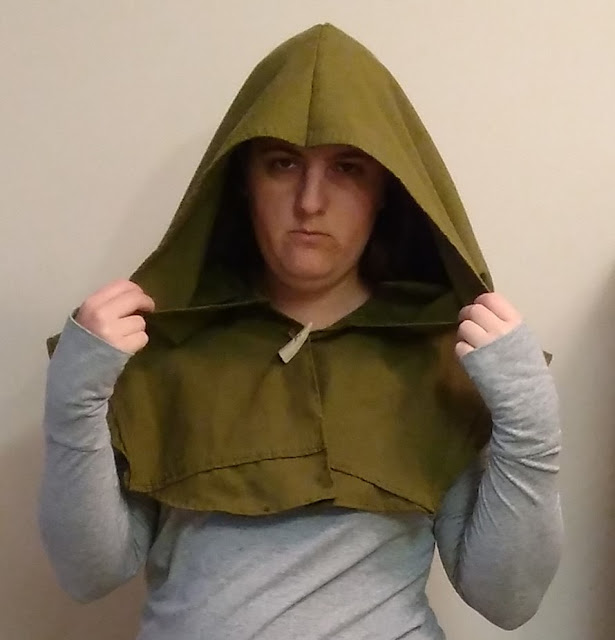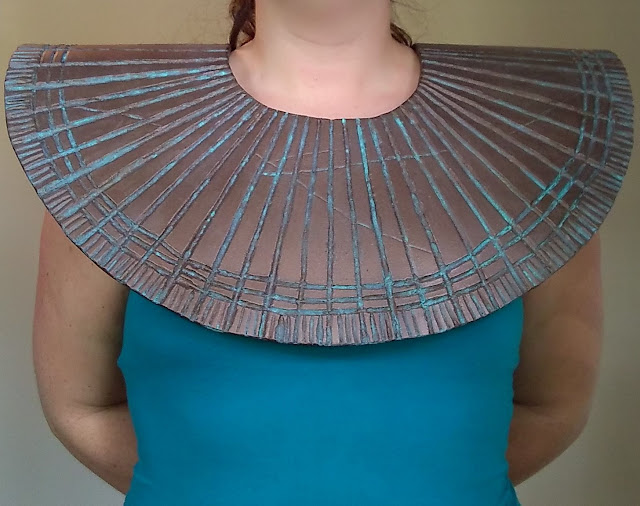How to make rebel pilot leg flares
Another basic part of the Iden Versio costume or any other rebel pilot are the leg flares and flare holder. It's the gray/olive band holding 8 silver "flares" on the left leg of Rebellion pilots in New Hope, Empire Strikes Back, and Return of the Jedi. There's a great tutorial using olive nylon webbing by Gil Guemes aka JediXXL at Rebel Legion, but since I couldn't find suitable webbing I adapted this for using basic fabric instead.
Inspiration
Materials
-Olive green heavy fabric
-3/4 inch diameter wooden dowel
-Silver spray paint
-Clear coat spray enamel
-Snaps (or Velcro)
Tools
-Hacksaw
-Sandpaper
-Needle/thread
-Snap tool
1. Gather the materials
2. Make the flares
To make the flares, I chose to simply spray-paint a wooden dowel cut into segments. The wooden dowel was 36 inches in length, so I sawed it into nine 4-inch segments. Four inches is the definite specification for the flares at Rebel Legion, though the diameter seems to vary. The one tutorial I found at Rebel Legion recommended 7/8-inch diameter, but honestly I thought this was excessive and I couldn't find that at the craft store. That specification seems to vary by source anyway. When sawing, try to keep the ends flat as you can. I'm still mastering the hacksaw, so mine came out a little wonky.
When finished, I picked the eight most similar segments, and the sanded down the cut edges with a bit of sandpaper.
Next, spread the flares out on newspaper or some other painting-friendly surface in a well-ventilated area. With smooth passes and even layers, spray paint the flares. Rotate flares to be sure of covering all sides. Allow for drying between layers. Finally add a top layer of clear coat enamel to seal the paint. Allow to dry. The effect is a little less polished on a closer look, but the metallic/hammered metal look of this spray paint is decent at disguising the fact it's wood (at least at a distance).
3. Sewing for the flare holder
First I measured my calf's diameter while wearing the flightsuit, so that I can accurately estimate the needed length. For the base of the leg flare holder I cut a rectangle that is the 8in wide by 18in long, which is longer than the calf diameter but better too long than too short. For the strip to hold the flares in place I cut a rectangle of 4in wide by 24in long, as the strip needs to be longer as it will have to go up and around the flares.
Next, fold over the long edges of the base of the flare holder so they meet in the middle of the back. Pin this into place so that the width is consistent throughout the strip. The base rectangle will be 4in wide and the strip rectangle will be 2in wide.
Fold down the narrow ends over twice and sew into place with a basic running stitch, so that the ends will not come undone and fray.
About a quarter inch from the top and bottom along the long sides, use a running stitch to secure the folds into place. This also makes the edges more uniform and adds some nice detail. Repeat this process with the flare holder's strip.
4. Attaching the flares
Securing the flares into the flare holder can be done in various ways. I decided to keep it simple and just sew the flare slots as tight to the flare as possible, and trust the snug fit to keep them in place (edit 1/17/21: I was wrong a snug fit helps but you need something more, I will be tacking the flares in place). This could be improved by gluing them into, or using tacks as is done in the Gil Guemes tutorial. First figure out the spacing of the flares along the flare holder. The spacing will differ slightly depending on the length of the flare holder, and the distance apart doesn't matter as long as it's consistent spacing. Pin the strip into place on the base of the holder so that it fits around the flares.
For sewing them into place, all you need is the running stitch. Without the flare, add a line of running stitch.
Once done, slide in the flare so that it is tight against that line of running stitch. Add a second line of running stitch on the other side as close to the flare as possible to keep it snug.
Repeat the process for the other seven flares.
5. Finishing touches
The last step is to have a way for the flare holder to wrap around the calf and hold in place. This can be done with Velcro, snaps, safety pins, etc. but I decided to use snaps. I figured out the best position of a pair of snaps again by trying it out on the leg, marked the locations with silver paint.
I then added the snaps, using a basic snap tool.
I chose to use two snaps (about 3/4in from each other's center points) for added strength.
And there you have it, another way to make a rebel pilot's leg flares and flare holder from Episodes 4 through 6! A variation of this would also do well to recreate the one from the later episodes. It's a small piece, but essential for various face characters and anonymous rebel pilots alike. Good luck and keep crafting!
Inspiration
Materials
-Olive green heavy fabric
-3/4 inch diameter wooden dowel
-Silver spray paint
-Clear coat spray enamel
-Snaps (or Velcro)
Tools
-Hacksaw
-Sandpaper
-Needle/thread
-Snap tool
1. Gather the materials
First I had to locate just the right fabric. The original Gil Guemes tutorial recommended using olive green 2-inch wide nylon webbing at the basis for the flare holder. Unfortunately I could find none in local craft or hardware stores. Instead I roamed a fabric store looking for just right olive green fabric. The idea was to come as close to a military-grade fabric. After several passes, I finally found this fabric in the remnants pile. There is some argument as to whether Iden Versio's flare holder is really more of a gray, as it seems to match her shirt in some of the cutscenes, but I decided to opt for what we see is the common flare holder for rebel X-wing pilots, seeing as it's part of a common uniform. I already had a gray thread, so I opted for that, but ideally it should be olive-green, or anything that's close to matching the fabric. If you need snaps and/or a snap tool, that's easy to find at a fabric store or most craft stores. If opting for Velcro, that's even easier at any hardware store, craft, or Walmart-scale store.
For the flares, you need a 3/4 or 7/8inch diameter wooden dowel about a 36inches (aka 1yd) long. You can find dowels at craft stores and usually at hardware stores.
Silver spray paint, clear coat enamel, hacksaw, and sandpaper were already in my possession, but they can be acquired at any self-respecting hardware store.
2. Make the flares
To make the flares, I chose to simply spray-paint a wooden dowel cut into segments. The wooden dowel was 36 inches in length, so I sawed it into nine 4-inch segments. Four inches is the definite specification for the flares at Rebel Legion, though the diameter seems to vary. The one tutorial I found at Rebel Legion recommended 7/8-inch diameter, but honestly I thought this was excessive and I couldn't find that at the craft store. That specification seems to vary by source anyway. When sawing, try to keep the ends flat as you can. I'm still mastering the hacksaw, so mine came out a little wonky.
When finished, I picked the eight most similar segments, and the sanded down the cut edges with a bit of sandpaper.
Next, spread the flares out on newspaper or some other painting-friendly surface in a well-ventilated area. With smooth passes and even layers, spray paint the flares. Rotate flares to be sure of covering all sides. Allow for drying between layers. Finally add a top layer of clear coat enamel to seal the paint. Allow to dry. The effect is a little less polished on a closer look, but the metallic/hammered metal look of this spray paint is decent at disguising the fact it's wood (at least at a distance).
3. Sewing for the flare holder
First I measured my calf's diameter while wearing the flightsuit, so that I can accurately estimate the needed length. For the base of the leg flare holder I cut a rectangle that is the 8in wide by 18in long, which is longer than the calf diameter but better too long than too short. For the strip to hold the flares in place I cut a rectangle of 4in wide by 24in long, as the strip needs to be longer as it will have to go up and around the flares.
Next, fold over the long edges of the base of the flare holder so they meet in the middle of the back. Pin this into place so that the width is consistent throughout the strip. The base rectangle will be 4in wide and the strip rectangle will be 2in wide.
Fold down the narrow ends over twice and sew into place with a basic running stitch, so that the ends will not come undone and fray.
About a quarter inch from the top and bottom along the long sides, use a running stitch to secure the folds into place. This also makes the edges more uniform and adds some nice detail. Repeat this process with the flare holder's strip.
4. Attaching the flares
Securing the flares into the flare holder can be done in various ways. I decided to keep it simple and just sew the flare slots as tight to the flare as possible, and trust the snug fit to keep them in place (edit 1/17/21: I was wrong a snug fit helps but you need something more, I will be tacking the flares in place). This could be improved by gluing them into, or using tacks as is done in the Gil Guemes tutorial. First figure out the spacing of the flares along the flare holder. The spacing will differ slightly depending on the length of the flare holder, and the distance apart doesn't matter as long as it's consistent spacing. Pin the strip into place on the base of the holder so that it fits around the flares.
For sewing them into place, all you need is the running stitch. Without the flare, add a line of running stitch.
Repeat the process for the other seven flares.
5. Finishing touches
The last step is to have a way for the flare holder to wrap around the calf and hold in place. This can be done with Velcro, snaps, safety pins, etc. but I decided to use snaps. I figured out the best position of a pair of snaps again by trying it out on the leg, marked the locations with silver paint.
I then added the snaps, using a basic snap tool.
I chose to use two snaps (about 3/4in from each other's center points) for added strength.
And there you have it, another way to make a rebel pilot's leg flares and flare holder from Episodes 4 through 6! A variation of this would also do well to recreate the one from the later episodes. It's a small piece, but essential for various face characters and anonymous rebel pilots alike. Good luck and keep crafting!
























Comments
Post a Comment